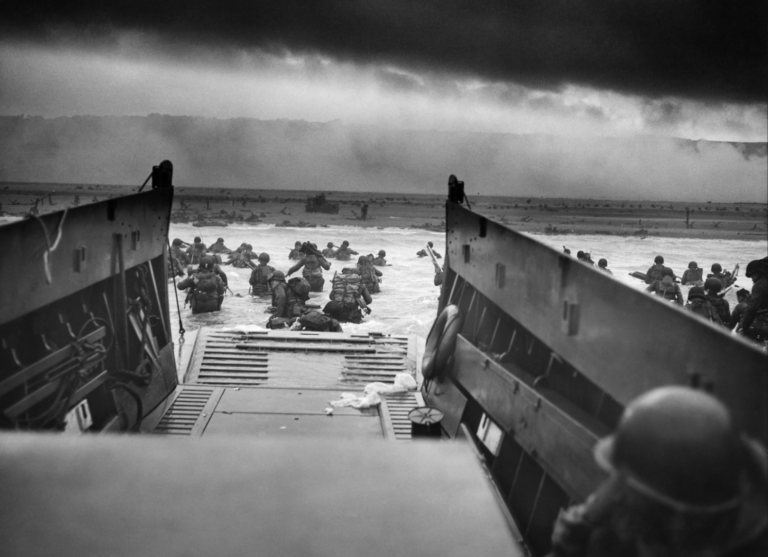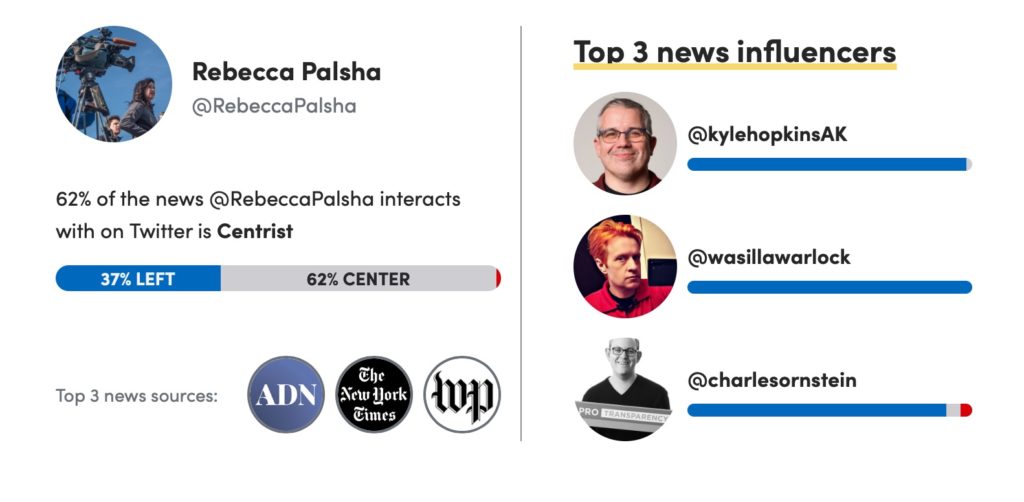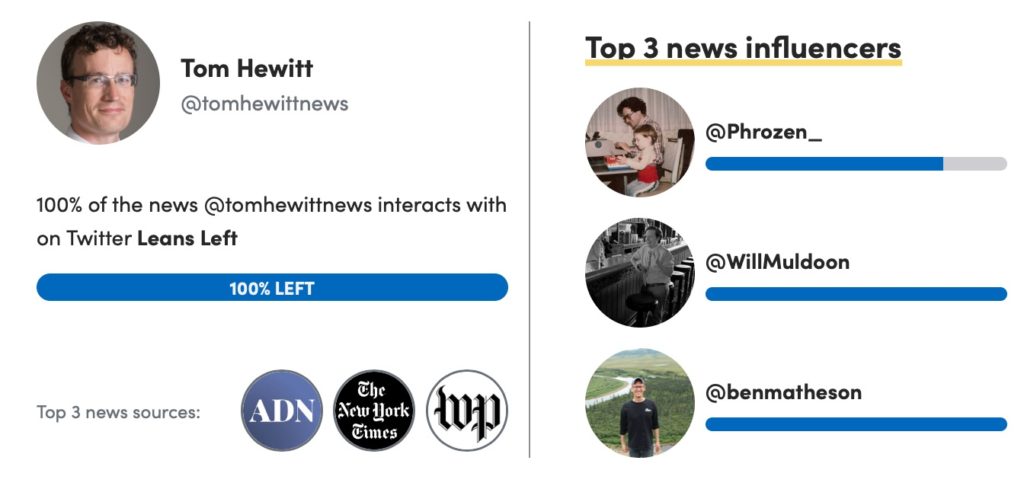A new tool by the website Ground.News reveals how people with Twitter accounts are interacting with news sources, and who is influencing them on Twitter. It is revealing when it comes to Alaska journalists, who dominate the Twitter universe in Alaska, and who also shape the narrative of the news.
Ground News’ main emphasis is to analyze news reports from across the globe. Readers can see results from an algorithm that shows whether left-leaning media has a blindspot to the story, and which stories right-leaning media is ignoring.
In addition, readers can use a tool on the site to analyze Twitter and Reddit accounts for who their account owners “like,” “share,” and otherwise interact with.
Must Read Alaska analyzed the accounts of many of the people who shape the mainstream media coverage in Alaska to see if they are interacting mostly on one end of the spectrum.
The results may not surprise readers:
Dave Hulen, the editor of the Anchorage Daily News, interacts 98 percent of the time with left-bias news sources on Twitter, including the newspaper he edits.
Must Read Alaska used the “blindspot” tool to compare Hulen to Must Read Alaska’s account which interacts with 75 percent right-leaning Twitter sources.
Hulen’s top three news sources are the ADN, USA Today, and the Los Angeles Times. His top three news influencers are Marc Lester, ADN photographer; Dr. Anne Zink, Alaska’s chief medical officer; and Charles Ornstein, of ProPublica.
Downing’s top three news sources include NewsMax, where she writes a column; Fox News; and BitChute. Top influencers are Kevin Showalter, who regularly badgers Dr. Anne Zink on Twitter over state Covid policy; Jack Posobiec, who is described by Wikipedia as an “alt-right and alt-lite political activist, conspiracy theorist, television host, journalist, and Internet troll;” and Paul Thacker, an X Games X Games medalist and outdoor enthusiast.
Here are the results for a handful of other journalists in Alaska who are on Twitter regularly:
Rebecca Palsha, Alaska’s News Source: 62% of the news @RebeccaPalsha interacts with on Twitter is centrist, 37% is left. Top three sources are: ADN, New York Times, Washington Post. Top three influencers are Kyle Hopkins, WasillaWarlock, and Charles Ornstein.
Kyle Hopkins, ADN’s Pulitzer Prize winner: 98% of the news @kylehopkinsAK interacts with on Twitter leans left, 2% is centrist. Top three sources are: ADN, ProPublica, New York Times. His top three influencers are Charles Ornstein. of ProPublica; Elizabeth Harball, of Alaska Public Media’s Energy Desk; and Hopkins’ wife, Rebecca Palsha, of Alaska’s News Source.
Elizabeth Harball, Alaska Public Media Energy Desk: 94% of the news @ElizHarball interacts with on Twitter leans left, 6% is centrist. Top three sources are: ADN, Washington Post, New York Times. Top three influencers are Kyle Hopkins, David Hulen, Michelle Theriault Boots.
Michelle Theriault Boots, ADN: 95% of the news @Theriault_Boots interacts with on Twitter leans left, 5% is centrist. Top three sources are: ADN, New York Times, Washington Post.
Tom Hewitt, editorial page editor for ADN: 100% of the news @tomhewittnews interacts with on Twitter leans left. Top three news sources are ADN, New York Times, Washington Post. Top three influencers are Henry Cole, Will Muldoon, Ben Matheson.
Ryan Binkley, publisher of the ADN, isn’t a regular Twitter user, but his biggest influencers on Twitter are Howard Weaver (former ADN editor), Tom Hewitt, and Kyle Hopkins.
James Brooks, ADN: 95% of the news @AK_OK interacts with on Twitter leans left. Top three sources are: ADN, CBC News, New York Times. Top three influencers are National Weather Service Juneau, Matt Buxton (leftist political blog), David Reamer (historian).
Matt Buxton, Midnight Sun AK blog: 100% of the news @mattbuxton interacts with on Twitter leans left. Top three news sources are ADN, CBC News, CNN. Top three influencers are Alaska Landmine (blog), Andrew Kitchenman (KTOO), James Brooks (ADN).
Alaska Landmine: Not enough data. Top three influencers are James Brooks, Matt Buxton, Dave Stieren.
Amanda Bohman, Fairbanks Daily News-Miner: 40% of the news @FDNMborough interacts with on Twitter leans left, 20% leans right, 40% is centrist. No top three news sources listed. Top three influencers are Tom Hewitt (ADN editorial page editor), ZubyMusic, and Samantha Godwin.
Nat Herz, Alaska Public Media Energy Desk: 96% of the news @Nat_Herz interacts with on Twitter leans left. Top three news sources are ADN, Indian Country Today, Associated Press. Top three influencers are Alaska Public Media, Alaska Landmine, Tegan Hanlon (Alaska Public Media).
Tegan Hanlon, Alaska Public Media: 96% of the news @teganhanlon interacts with on Twitter leans left. Top three news sources are ADN, New York Times, Washington Post. Top three influencers are Alaska Public Media, Liz Ruskin (APM), and KTOO.
If all the journalists in Alaska seem to be heavily left leaning, there is one bright spot: Becky Bohrer, AP reporter in Juneau. The algorithm rates her 100 percent centrist.
Try the Twitter Blindspotter tool yourself at this link.












